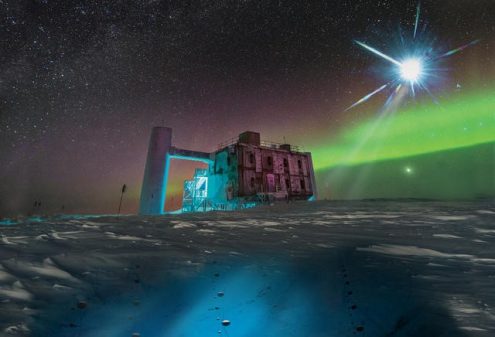Oscillating “ghost particles” caught at the South Pole help solve an astrophysical riddle
DNRF Niels Bohr Professor Subir Sarkar and Professor Jason Koskinen are part of a global collaboration that, with the help of the neutrino observatory IceCube, have discovered for the first time the connection between the emission of neutrinos and radiation from active galaxies called blazars.

Far beneath the surface of the ice at the South Pole is the IceCube Neutrino Observatory, a gigantic research station that tries to catch glimpses of elementary particles called neutrinos, which are extremely difficult to detect. With IceCube’s help, Professor Jason Koskinen, who is part of the research group linked to Professor Subir Sarkar’s Niels Bohr Professorship, in collaboration with an international research team, has detected energetic neutrinos and found that their origin is connected to a type of active galaxies called blazars. The groundbreaking discovery has been published in the journal Science and is the cover story of the journal’s issue.
The oscillating neutrinos are also called “ghost particles” because of their extreme speed and because, without interacting with intermediate substances, they can travel through the universe without being stopped. Neutrinos are among the most prevalent types of particles, but unlike every other known particle, neutrinos do not have any electrical charge. This means that they rarely interact with other particles and therefore can skate directly through everything from the human body to the rest of the planet without revealing themselves. Thus, researchers have great difficulty observing these ghost particles and must use enormous custom-made neutrino observatories such as IceCube to catch a glimpse of them.
In 2013, a research team at IceCube detected a very energetic type of neutrinos, but they could not trace where the particles came from. Since then, the origins of the high-energy-neutrinos have remained a mystery to scientists, but in late September of last year, the international research team – with the participation of Koskinen and Sarkar – detected another energetic neutrino. Their observations gave the researchers the impression that the particle came from four billion light years away. At the same time, the researchers registered increased gamma radiation from the same direction as the neutrino. It turned out that the radiation came from a so-called blazar – an active galaxy with a core consisting of one or more black holes that release electromagnetic radiation into cosmos with extreme speed.
In their new study, the researchers argue that the two merging events are connected. The discovery is a major breakthrough within astrophysics because it shows that neutrinos can be used as astronomic messengers that can help us understand the universe.
“We had ideas as to where the energetic neutrinos could come from, but we have been missing the proof. But now we know that this neutrino came from an active galaxy core,” said Sarkar.
It is the first time that researchers have discovered the connection between the emission of energetic neutrinos and electromagnetic radiation from powerful blazars. The discovery is particularly notable because the mysterious ghost particles are created under cosmic fusion processes such as the Big Bang and they also occur in supernova explosions and in stars like the sun. In that way, the particles are informational messengers that can potentially provide answers to some of the secrets of the universe.
Thus, the researchers’ discovery of the connection between blazars and neutrinos is a crucial step toward a better understanding of where neutrinos and cosmic radiation come from and therefore marks a milestone in the exploration of space.
“We have long been wondering where these elementary particles occur, and now we have strong proof that blazars are a source of this type of high-energy neutrinos. The discovery is a very important part of our understanding of the universe and the most energetic and powerful object in it,” said Professor Koskinen.
IceCube is the world’s largest neutrino detector, and around 300 astrophysicists from 49 different institutions spread over 12 countries are engaged in the project. The Antarctic neutrino observatory includes the surface detector IceTop as well as the underground DeepCore, which makes IceCube a multipurpose research station where researchers can examine some of the greatest and most central questions of the universe.
Read the scientific article in Science here.
Read more about the discovery at Copenhagen University here.
Further information about IceCube can be found here.
